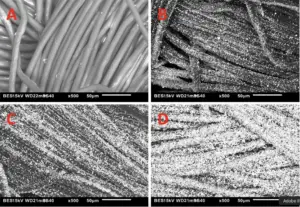


PLASMA SCIENCE AND TECHNOLOGY RESEARCH GROUP
UNIVERSITY OF THE PHILIPPINES BAGUIO
UPB PLASMA SCIENCE AND TECHNOLOGY RESEARCH GROUP
Established in 2016 through the Institution Development Program (IDP) of the Philippine Council for Industry, Energy, and Emerging Technology Research and Development (DOST-PCIEERD), the Plasma Physics Research Group at UP Baguio serves as a dynamic hub for innovative research and education in plasma physics and technology. This pioneering initiative provides a robust platform for students and researchers to delve into plasma-related thesis works and institution-funded projects, significantly advancing the frontiers of science in the region.
The Plasma Physics Laboratory is at the heart of this research group, concentrating on plasma diagnostics, plasma processing of materials and biological samples, and the simulation of atmospheric pressure plasmas. Since its inception, the laboratory has achieved remarkable milestones, contributing substantially to both academic and scientific communities. Among these accomplishments are:

Mentorship and Graduation:
Successfully mentored and graduated around 40 students from the BS Physics and Biology programs, fostering a new generation of skilled scientists.
Student Engagement:
Hosted nearly 20 students from the Philippine Science High School for their Immersion Program, providing hands-on experience and inspiring young minds to pursue careers in science and technology.
Scholarly Contributions:
Presented over 20 scientific papers at prestigious national and international conferences, showcasing groundbreaking research and developments.
Balik-Scientist Program:
Welcomed Dr. Jethro Salapare, a distinguished scientist, through the Balik-Scientist Program, enriching the research environment with his expertise and global perspective.
Publications:
Published six significant research papers in reputable scientific journals, reflecting the high quality and impact of the research conducted.
Interdisciplinary Collaborations:
Forged strong partnerships with various universities and collaborated across disciplines within UP Baguio, including Mathematics, Biology, Chemistry, Geology, and Social Sciences, promoting a holistic approach to scientific inquiry and innovation.
The Plasma Physics Research Group at UP Baguio stands as a testament to the power of collaborative research and education, driving progress and fostering excellence in the field of plasma physics. Through its continued efforts, the group not only advances scientific knowledge but also contributes to the development of skilled researchers and professionals poised to address the challenges and opportunities of the future.
Research Projects:
Completed six research projects, each contributing valuable insights and advancements in the field of plasma physics.

Announced that a Physics Laboratory will open at UP Baguio
Scan the QR to view Photos

Publications
International Publications
[1] Ocampo, Isaiah, et.al.: Ar/02 Atmospheric plasma jet treatment of pure cotton fabric for antibacterial application; Plasma and Fusion Research, Volume 13, 3406116 (2018), DOI: 10.1585/pfr. 13.3406116
[2] Baoanan, Klanz, et.al.: Synthesis of silver nanoparticles on stainless steel for antibacterial applications via atmospheric pressure plasma jet – APJSME-2019-215Asia-Pacific Journal of Science, Mathematics and Engineering (APJSME – ISSN 2244-5471)
[3] Buensuceso, Jaun Lawrence, et.al.: Production of Plasma-Activated Water via Atmospheric Pressure Plasma Jet to Prolong the Shelf Life of Strawberries APJSME-2019-214 Asia-Pacific Journal of Science, Mathematics and Engineering (APJSME – ISSN 2244-5471)
[4] Malapit, G, et.al.; Bactericidal efficiency of silver nanoparticles deposited on polyester fabric using atmospheric pressure plasma jet system. https://doi.org/10.1080/00405000.2021.1954426
[5] Baculi, R. et.al.: Atmospheric pressure plasma deposition of silver nanoparticles on bark fabric for bacterial growth inhibition. https://doi.org/10.1080/00405000.2021.2024378
[6] Antonio, J., et. al.: Lead (Pb 2+ ) removal in water using different forms of spent arabica coffee grounds at varying contact time.
August 2022 ES Web of Conferences 355(1)
DOI: 10.1051/esconf/202235502001
Conference: Research, Invention, and Innovation Congress at Bangkok, Thailand
BS Physics & BS Biology Theses
- Nescy Leann F. Galban – Effects of Copper Negative lon Beam on Ceramic Substrates via Plasma Sputter-type Negative lon Source (2014) : Oral Presentation, The Ist International Symposium of the Vacuum Society of the Philippines 2016
- Meica B. Ombao – Investigation of Aluminum Negative lon Beam Profile For Thin Film Deposition (2014): Oral Presentation, The lst International Symposium of the Vacuum Society of the Philippines 2016
- Sushmita T. De Guzman – Deposition of Niobium on Stainless Steel using Plasma Sputter-type Negative lon Source (2014)
- Alex Kevin Marc C. Alonzo – Au-Beam Profiling for Gold Deposition in a Plasma Sputter-type Negative lon Source (2014)
- Mercy Ann De Los Santos – A Novel Atmospheric Pressure AC Plasma Jet System for Deposition of Titanium and Titanium Dioxide on Silicon Wafers (2015): Output, Cordillera Studies Center Research Grant 2015
- Astrid Jireh Deang – Ar Atmospheric Plasma Jet-Treated Porous Ceramic Filter with embedded Ag Particles for Antimicrobial Treatment of Rainwater (2016): Poster Presentation: 18th Samahang Pisika ng Visayas at Mindanao National Physics Conference 2016, Oral Presentation, 35th Samahang Pisika ng Pilipinas Physics Conference 2017
- Clifford Daduya – Synthesis of NbOy via an Atmospheric Pressure Plasma Jet System (2016): Poster Presentation: 18th Samahang Pisika ng Visayas at Mindanao National Physics Conference 2016
- Kristine Joy B. Fernandez – Characteristics of Ceramic Coating on AZ31B Mg alloy synthesized via Multiple Plasma Electrolytic Oxidation (2017): Poster Presentation, The 2nd International Symposium of the Vacuum Society of the Philippines 2018
- Beverly Jane Banga – Characteristics of Chromium-modified ZnO Film Deposited using Atmospheric Pressure Plasma Jet and Its Photolytic Efficiency Under Visible Light Illumination (2017): Poster Presentation, The 2nd International Symposium of the Vacuum Society of the Philippines 2018
- Isaiah Noel D. Ocampo – Antibacterial Activity of Silver Nanoparticle-coated Pure (100%) Cotton Traditional Textiles via Atmospheric Pressure Plasma Jet (2017): Poster Presentation, 26th International Toki Conference (ITC-26) 11th Asia Plasma and Fusion Association Conference (APFA-11) 2017, Published in the Plasma and Fusion Research Volume 13, 3406116 (2018), Oral Presentation: 20th Samahang Pisika ng Visayas at Mindanao National Physics Conference 2018 Winner :SPVM 2018 Surya Raghu Entrepreneural Award
- Nathalia Joy Garcia – Synthesis and Deposition of Zirconium/Zirconium Oxide using Ar-O2 Atmospheric Pressure Plasma Jet on Plasma Modified Surfaces of Polyimide Films (2017): Poster Presentation, The 2nd International Symposium of the Vacuum Society of the Philippines 2018
- Alexis Soriano – Enhancement of the Hydrophobic Property of 100% Cotton Cordillera Woven Textile Using the Atmospheric Pressure Plasma Jet (2017)
- Mary Anne Corleto – Surface Modification of PDMS via an Atmospheric Pressure Plasma Jet System (2017): Poster Presentation, The 2nd International Symposium of the Vacuum Society of the Philippines 2018
- Haromi Lican,
- AlejaMaremilla, and
- Karl Moscoso – Effects of Argon-Oxygen Atmospheric Pressure Plasma Irradiation on the Germination and Growth of vigna radiata (2017)
- Charlotte Balderas – Effect of Oxygen Gas Flow Rate to the Adhesion of ZnO to Polyethylene Terephthalate (2017)
- Klanz Baoanan – Synthesis of Silver Nanoparticles on Stainless Steel via Atmospheric Pressure Plasma Jet and Its inhibitory Activity Against e. coli and s. aureus (2018): Oral Presentation: 20th Samahang Pisika ng Visayas at Mindanao National Physics Conference 2018, Published 2019
- Shaira Joi Isaac – Assessment of the Effects of Argon-Air Atmospheric Pressure Plasma On the Early Development of Phaseolus vulgaris, Cajanus cajan and Vigna radiata (2018); Ouput, Part of Cordillera Studies Center Interdisciplinary Research Grant 2017
- Jean Angelique Sarra – An Atmospheric Pressure Glow Discharge Plasma Setup for the Disinfection of Bacteria-Contaminated Water (2018)
- Ma. Beatriz Dela Cruz, and
- Nathaniel Lorenz Flores – Effects of Plasma-Activated Water on the Growth and Development of Solanum lycopersicum (2018)
- Matthew Franz Oco – Simulation of Low Frequency Atmospheric Pressure Plasma in Argon using Particle in a Cell-Monte Carlo Collision Model (2018)
- Jaun Lawrence Buensuceso – Production of Plasma-Activated Water via Atmospheric Pressure Plasma Jet to Prolong the Shelf Life of Strawberries (2018): Oral Presentation: 20th Samahang Pisika ng Visayas at Mindanao National Physics Conference 2018, Published 2019
- Hana Taguchi – Sterilization Efficacy of Argon and Nitrogen Against Escherichia coli via Atmospheric Pressure Plasma Jet (2019): Poster Presentation, The 3rd International Symposium of the Vacuum Society of the Philippines 2020
- Russel Paul B. Calubaquib – Fungicidal Efficiency of Cold-Plasma Activated Water via Pin to Plate Discharge Against Trischosporon jirovecii (2019): Poster Presentation, The 3rd International Symposium of the Vacuum Society of the Philippines 2020
- Rey Benedict A. Villacillo – Investigation of Physico-chemical and Flame Retardant Property of Boric Acid Under Nitrogen-based Gliding Arc (2019): Poster Presentation, The 3rd International Symposium of the Vacuum Society of the Philippines 2020
- Joseph Victor T. Fronda – Numerical Study on the Time-dependence of an Atmospheric Pressure Argon Plasma Jet System with the Drift Diffusion Fluid Model (2019): Poster Presentation, The 3rd International Symposium of the Vacuum Society of the Philippines 2020
- Janus Dale Mitra – Adhesion Analysis of Silver Nanoparticles on Pure (100%) Cotton Traditional Textiles (2019): Poster Presentation, The 3rd International Symposium of the Vacuum Society of the Philippines 2020
- Samuel Harrison Cerrudo – Investigation of Surface Modification and Copper Nanoparticle Production on Processed Lignocellulose and its Antifungal Mechanisms via Atmospheric Pressure Plasma Jet treatments (2019): Oral Presentation, The 3rd International Symposium of the Vacuum Society of the Philippines 2020
- Thomas Gerard Barrot – Investigation of the Optical Properties of Copper Oxide Micron/Submicron Particles Grown Via Atmospheric Pressure Plasma Jet (2020), Subplenary Oral Presentation, Samahang Pisika ng Visayas at Mindanao International Conference 2021
- Micah Stephanie Israel – Analysis of the effect of atmospheric plasma on the thermal stability of natural zeolites (2021) Oral Presentation to the 4th International Symposium of the Vacuum Society of the Philippines 2022
- Lenie Ann Balegan – Dielectric Barrier Discharge Plasma Treatment of Glycine Max (L.) Merill for Improved Germination and Growth: A Systematic Review (April 2022)
- Aleander Keihl Magtoto – Plasma-activated Water (PAW) in Increasing the Shoot Production of Grape Vines (Vitis vinifera) from Cutting (August 2023): Oral Presentation to the 5th International Symposium of the Vacuum Society of the Philippines 2024
- Reo Maverick Rangcapan – Effect of atmospheric pressure plasma treatment on hydrophobicity of pure Abaca (Musa textilis) fabric (November 2023)
- Jericho Mascarina – Plasma Activated Water and its Potential Cytogenotoxic Effect on Allium cepa (December 2023): Oral Presentation to the 5th International Symposium of the Vacuum Society of the Philippines 2024
- Elisa Jemimah Pineda – Ar-02 Plasma Surface Modification of Pure Cotton Textile for Enhanced Hydrophilicity and Optimized Dyeability via Response Surface Methodology (February 2024)
- Claire Tagasa – Textile Functionalization: Increased Wettability and Antibacterial Potential of Atmospheric Pressure Non-Thermal Plasma-Treated Pure Philippine Silk (May 2024)
- Jamille De Vera – Enhanced Removal of Methylene Blue Organic Contaminants with Atmospheric Pressure Plasma Jet Modified Pine (Pinus Sp.) Cone Adsorbent (June 2024):
- John Polo Bernardo – Investigating the Effects of Direct and Indirect Atmospheric Pressure Plasma Treatment on the Germination and Seedling Development of Soybean Seeds (Glycine max) (June 2024)
- Jayevic Villasenor – Assessing the Antifungal Efficiency of the Synthesized Silver Particles on Kawayan Tinik (Bambusa blumeana) (June 2024)
- Jeannee Sumedca – Coaxial Water Falling Dielectric Barrier Discharge on the Degradation of Synthetic Dyes: A Systematic Review (June 2024)
Maria Angelica C. Quilban – Plasma-Activated Water as a Novel Biocontrol for Pathogen Management in Brassica rapa var. pekinensis Production (December 2024)
Justin Vonn S. Martinez – Enhancing Surface Properties of Polyethylene (PE) – coated Paperboard via Ar-O2 Atmospheric Pressure Plasma Jet (APPJ) Treatment and Silver Nanoparticle Deposition (December 2024)
Dominic B. Soriano – Degradation of Malachite Green and Natural Cordilleran Orange Dyes as Wastewater Pollutants using Direct and Plasma-Activated Water Treatments via Non-Thermal Atmospheric Pressure Ar-O2 Plasma Jet (December 2024)
Maurice Sydelle B. Santos – Effects of using N2/O2 Plasma Activated Water (PAW) as a Nitrate Source on the Shoot Growth of Brassica oleracea var. Italica through Atmospheric Pressure Plasma Jet (APPJ) System (December 2024)
Mark Joshua R. Secretario – Flame Retardant Application of Ar/N2 Atmospheric Pressure Plasma Jet Treated Boric Acid on Pure Cotton Fabric (December 2024)
Mark Joseph Magbalita – Effect of Cold Plasma Treatment on Physicochemical and Phytochemical Properties of Polished CLSU CLS-7 Pigmented Rice (February 2025)
Maria Alecxandriel Asinas – Computational Simulation of a Modified APPJ in Pure Argon: OES Comparison (May 2025)
Kian Zoe Dioquino – Enhancement of Plywood Fire Retardancy through Duration-Controlled Atmospheric Pressure Plasma Jet Deposition of Silver Particles (May 2025)
Ralph Lester Mesina – Atmospheric Pressure Ar/O2 Plasma Jet Treatment of Sludge Biochar for Improved Methylene Blue Adsorption (May 2025)
Christian Manuel Carrido – Synthesis of Graphene using Atmospheric Pressure Plasma Jet (APPJ) System (May 2025)
John Michael Basilio – Tuning ZnO Lattice Defects, Photocurrent Response, and Photoluminescence by Aluminum Doping and Ar/H2 Atmospheric Plasma (May 2025)
Mary Heart Jillbeth L. Parena – Ar/O2 Atmospheric Pressure Plasma Jet Treatment of Garlic Peel for Enhanced Rhodamine-B Adsorption (July 2025)
Projects
Antibacterial Effects of Silver Nanoparticle-coated Traditional Cordillera Textiles using Atmospheric Pressure Plasma Jet:
Plasma technology that operates at atmospheric pressure is increasingly used for surface modification of heat-sensitive materials to confer antibacterial properties. In this study, atmospheric pressure plasma jet (APPJ) system was used to deposit silver nanoparticles (AgNPs) for antibacterial application into bark fabric used in the Cordillera Region, Philippines. Plasma was produced by applying 15 kV to silver electrodes while the argon and oxygen gases were allowed to flow at 15 and 5 liters per minute (LPM), respectively. Characterization of plasma by optical emission spectroscopy (OES) suggests the formation of active plasma species. The observed surface roughness which consequently enhanced the adsorption of AgNPs was confirmed by scanning electron microscopy (SEM) and wavelength dispersive x-ray fluorescence (WDXRF) analyses. Fourier transform infrared spectroscopy – attenuated total reflectance (FTIR-ATR) results further revealed the removal of surface impurities as indicated by the production of carbon dioxide. Qualitative and quantitative antibacterial assays proved the efficiency of the samples in inhibiting the growth of bacteria namely Escherichia coli, Pseudomonas aeruginosa, and Staphylococcus aureus. The antibacterial efficiency of the samples proportionally increased with longer plasma treatment time. Atmospheric pressure plasma jet could serve as a promising deposition technique with potential application in the production of antibacterial fabrics.
Funding Agency:
Cordillera Studies Center (CSC) UP Baguio

Scanning electron micrographs revealing the presence of deposited silver nanoparticles in the A) control and polyester fabric exposed to atmospheric plasma for B) 1 min C) 3 min, and D) 5 min.
Effect of Oxygen-Argon Plasma Irradiation on Seed Germination and Seedling Growth of Vigna radiata using a Novel Atmospheric Plasma Jet System:
The effects of Argon-Oxygen (Ar-Oz) plasma on the seed germination and seedling growth were investigated by irradiation of Vigna radiata seeds using the atmospheric pressure plasma jet system. Scanning electron microscopy showed that wax depositions on the seed coat of the plasma-treated seeds were reduced. The resulting increase in the germination rate was associated with this modification, suggesting an increase in water and nutrient absorption by the seeds. Optical emission spectroscopy (OES) detected the presence of argon, oxygen, and niobium species. However, X-ray fluorescence (XRF) showed no incorporation of niobium species in the treated seeds. Peroxidases were also found present in the treated seeds, which suggests the role of reactive oxygen species (ROS) on the enhanced plant growth. After 30 days, growth measurement of the samples showed that plasma-treated plants have significantly increased shoot and root lengths, and plant weight.
Funding Agency:
Cordillera Studies Center (CSC) UP Baguio
Anthropological Analysis, Mathematical Symmetry and Technical Characterization of Cordillera Textiles:
Funding Agency:
Emerging Interdisciplinary Research (EIDR)
Book of Abstracts
UPB Plasma Science and Technology Group Photos



Plasma Science and Technology
Research Group
University of the Philippine Baguio
College of Science
Department of Physical Sciences
- 𝗚𝗲𝘁 𝗶𝗻 𝗧𝗼𝘂𝗰𝗵
- UP Baguio, Governor Pack Road, Baguio City, Philippines 2600
- upbplasmascience@gmail.com
- +63 (969) 569-4411
- UP Baguio Plasma Science and Technology Research Group